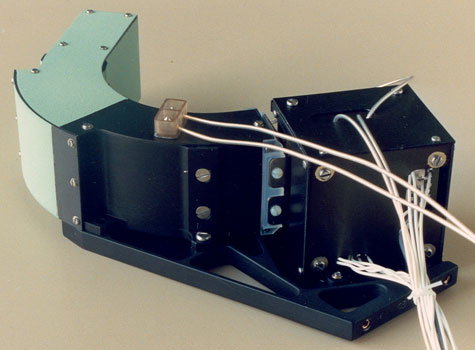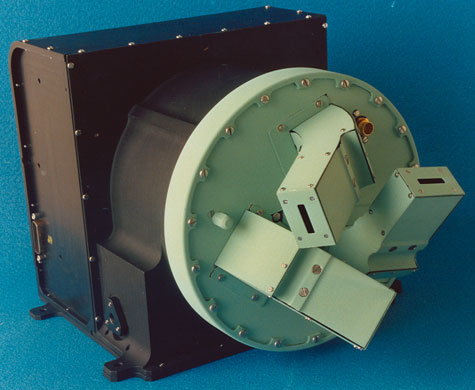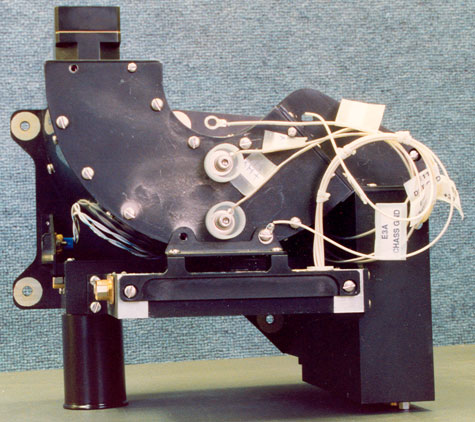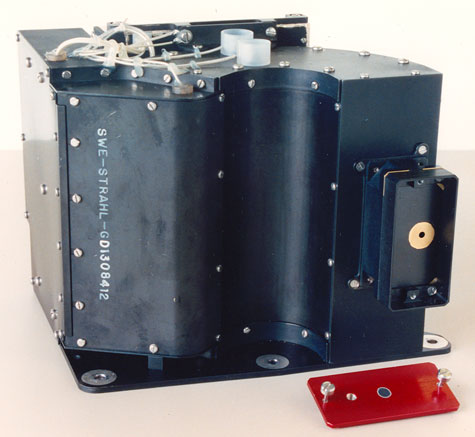Wind/SWE (Solar Wind Experiment) Electron Instruments, History and Data Products
electron instruments | operations history |
data overview | data details
Wind/SWE Electron Instruments
VEIS | Strahl Detector | top
Vector Electron/Ion Spectrometer (VEIS)
VEIS is described in detail in a Space Science Reviews
article by Ogilvie et al. [1995]. top
  |
The VEIS is an instrument designed for determining in detail the distribution functions of ions and electrons over the energy/charge
range from 7 V to 24.8 kV. It consists of two opposing sets of three small electrostatic analyzers which are identical and
employ balanced deflection through 127° in a cylindrically-symmetric electric field. These components are depicted on
the left; the top image showing some details of a single detector, and a completed triad assembly being shown on the bottom.
Electrons are detected by channel electron multipliers. The field of view of each analyzer is determined solely by a collimator
at the entrance and by the sensitive area of its single (per species) channeltron detector.
The calculated energy response of each analyzer is narrow, providing a differential energy window of ΔE/E ≈ 0.06 and
a substantial geometric factor (4.6 × 10-4 cm² sterad). These analyzers have approximately 7.5°
× 6.5° fields of view; using them to obtain 3-D coverage entails the assumption that each direction of view is
representative of a larger angular region, i.e., each of the six analyzers must represent approximately 4π /
6 steradians. The minimum energy-step dwell time is 5 ms.
On a spinning spacecraft the spin causes the observations to be made along a curved path in velocity space. If, for example,
an energy scan of 16 points is made every 60° of spacecraft rotation, the distribution function obtained each spin by the six
detectors contains 6 × 16 × 6 = 576 points. This sampling scheme is representative of the various modes under
which VEIS was operated.
top
|
Electron Strahl Detector
The Electron Strahl Detector is described in detail in a Space Science Reviews
article by Ogilvie et al. [1995]. top
  |
The Electron Strahl Detector is a truncated, toroidal electrostatic analyzer with an included angle of 131°.
It was originally designed to characterize any magnetic-field-aligned beam or 'strahl' observed in the solar wind electron velocity
distribution over the energy/charge range from 5 V to 5 kV. The instrument is depicted on the left; the top and bottom images
showing views which reveal different details. (Note that a film canister, not part of the instrument, can be seen in the
bottom-left of the top image).
When mounted on the instrument deck of a spinning spacecraft, this device covers a field of view subtending about ±30°
with respect to the spin plane (normal to the spin axis), and about 3° of azimuth. The detectors are two channel plates,
respectively viewing above and below the spin plane.
Six anodes, each covering approximately 5° segments of their respective nominal 30° views, are used per plate.
The calculated energy response for each anode has ΔE/E ≈ 0.03, with a geometric factor of 7 × 10-4
cm² sterad. The minimum step time is 30 ms.
The original concept of Strahl Detector operations exploited spacecraft spin to make two series of contiguous observations, about every
4°, concentrated in the neighborhoods of look-directions both parallel and anti-parallel to the magnetic field direction.
The result was typically (depending upon operating mode) something like two 15 × 12 pixel maps each spin: one of the approximately
60° × 60° angular region nominally centered about the magnetic field direction, and one of the corresponding region
nominally centered about the opposing direction. This was generally carried out with fixed energy levels for each spin,
repeating sequentially over a series of (usually) 16 such levels.
top
|
Wind/SWE Electron Instrument Operations and Data Production History
1994-2001 | transition | 2002-present | top
November 1994 launch - June 2001
VEIS: Until the failure of its high-voltage power supply led to its being disabled, VEIS was operated under a variety of science
modes. These operations yielded science data products like electron moments and pitch-angle distributions (see overviews and details below),
and allowed all of the usual portrayals of the observed 3-D electron velocity distributions. top
Strahl: Until being reconfigured as described in the transition section, the Electron Strahl Detector was also operated in a
variety of science modes. These operations yielded science data products characterizing the electron strahl phenomenon (see overviews
and details below), and allowed high angular-resolution portrayals of its specialized magnetic-field-aligned electron distributions.
top
June 2001 - August 2002 transition
The Electron Strahl Detector was reconfigured during this time to operate in a fashion which allows it to gather observations approximating
those of the VEIS. Energy scans over the range from 19 eV to 1.2 keV (in 15 steps) are now carried out during three spins (with one
or more intervening spins of no observations). The sky-maps now cover 360° in azimuth, using eight 45° sectors; counts from the
12 anodes being pairwise binned into six pixels. The result is an 8 × 6 pixel map for each of 15 energies (13 unique--the last four
steps visit the last two energies twice each to improve statistics), about every 12-15 sec. top
August 2002 - present
Strahl (reconfigured): The Electron Strahl Detector is now operated only in its reconfigured science mode. Current
operations yield similar science data products to all of what was produced before the transition: electron moments, pitch-angle
distributions and characterizations of the electron strahl phenomenon (see overviews and details below), and allow portrayals of the visible
portion of the observed 3-D electron velocity distributions. top
Wind/SWE Electron Data Products Overview
electron moments | PADs |
PAD-regime averages | strahl analysis |
top
Electron Moments Overview
There are well-known techniques for finding macroscopic physical parameters characterizing the electron population of an observed plasma from
measured electron velocity distributions. The results of these sorts of statistical analyses are referred to as "electron moments"
here, regardless of the details of the particular techniques used. For example, the electron moments science data products described here
are in one approach derived from quadrature integration
and in a second approach from the fitting of a one-dimensional model (based on the
Kappa distribution) to the data.
Typical electron moments parameters are the plasma's number density, bulk flow velocity, thermal speed, kinetic
temperature, etc. Only a subset of this list might be available from some approaches, however the list may in some cases be extended
to include pressure tensor and heat-flux vector components. If the electron distributions are separable into regimes (e.g.
"core", "halo", "strahl", etc.), then these could be characterized separate from the full distribution.
Finally, when magnetic field data are available, the thermal parameters can be projected onto parallel and perpendicular axes (wrt the field),
and new geometric parameters like temperature anisotropy (possibly separable by regime) and gyrotropy can be made available.
top
Electron Pitch-Angle Distribution (PAD) Overview
Electron motion is strongly influenced by the local magnetic field; each particle roughly following a helix, of a certain pitch-angle, with the
field as its guiding center-axis. Over an observed electron population there will be a distribution of pitch-angles, usually characterized
at each observed energy. The typical means of characterization involves dividing the 0° (field-aligned) to 180° (anti-parallel)
interval of all possible pitch-angles into "bins", and populating them (at each observed energy) according to observation
frequency. For this work, the division scheme generally uses 30 6° bins.
The result of this analysis, "pitch-angle distributions" or "PADs", is something like a 30 × N (where N is the
number of time-steps) map of the distributions seen at each energy. The analysis produces another related product: "spin-averaged"
(meaning, in practice, that an average is found over the angular bins) maps of the time-varying distribution of the electron population in
energy. Note that these energy spectra are formed from a statistical approach which differs from the analytical approach that generates
the energy spectra described in the PAD-regime averages section below (see the
"New mode" Electron Pitch-angle Analysis paper for details).
top
Electron PAD-regime Averages Overview
In an attempt to reduce the data in PAD maps to a collection of time-series, averages (taken in an analytical sense described in the
"New mode" Electron Pitch-angle Analysis paper) are found for
key regimes of the PAD at each energy. The regimes used are PARA: including only quasi-parallel fluxes, PERP: including only
quasi-perpendicular fluxes, ANTI: including only quasi-anti-parallel fluxes, and OMNI: including all fluxes. Each type of regime-average
is found at each energy. Note that the OMNI-type average produces a sort of energy spectrum. top
Electron Strahl Analysis Overview
Before its reconfiguration, the Strahl Detector produced Az × El maps which may be searched for structures suggesting the signature of
the electron strahl phenomenon; these could be characterized to report an intensity, pitch-angle centroid, and pitch-angle width for quasi-parallel
and quasi-anti-parallel "beams" at each energy. Afterwards, the algorithm currently used for production was developed; the
"New mode" Electron Pitch-angle Analysis paper
describes how an equivalent product is now generated from PAD maps. top
Wind/SWE Electron Data Products Details
electron moments | PADs |
PAD-regime averages | strahl analysis |
top
Wind/SWE electron data products have a 'designation' containing either HX (high-resolution) or
MX (modified/derived), where X is a digit identifying a particular product.
Each product potentially has a different 'cadence', and cadences vary within a product such that only ranges may be specified.
There are multiple options for where these products are obtained, and what data-services are available.
Wind/SWE electron data products can be searched on and downloaded via the
Virtual Heliospheric Observatory (VHO).
All access via CDAWeb
requires selection of 'Wind' as a 'Source', and
'Plasma and Solar Wind' as an 'Instrument Type'.
All CDF files on the
instrument site have yyyymmdd-format dates, version number,
and most are gzip-compressed.
Any data access not specifically detailed here is via the Wind/SWE electron instrument science team.
top
Electron Moments Details
Electron moments parameters are derived from both quadrature ("old" and "new" modes) and fitting techniques (new-mode only). top
| Designation |
Description |
Cadence |
Format |
Location/Services |
WI_H0_SWE |
Old-mode (1994-2001) electron moments from quadrature (see
header-text,
CDF skeleton file).
|
6-12 sec |
CDF |
|
WI_H5_SWE |
New-mode (2002-present) electron moments from quadrature (see
header-text,
CDF skeleton file).
|
12-15 sec |
CDF |
|
WI_H2_SWE |
New-mode (2002-present) electron moments from fitting (see
header-text and
CDF skeleton file).
|
12-15 sec |
CDF |
instrument site
|
Electron Pitch-Angle Distribution (PAD) Details
Electron pitch-angle distributions are provided in their full temporo-angular resolution for all available periods. top
| Designation |
Description |
Cadence |
Format |
Location/Services |
WI_H4_SWE |
Old-mode (1994-2001) electron pitch-angle distributions (see
header-text,
CDF skeleton file).
|
6-12 sec |
CDF |
|
WI_H3_SWE |
New-mode (2002-present) electron pitch-angle distributions (see
header-text,
CDF skeleton file).
|
12-15 sec |
CDF |
|
Electron PAD-regime Averages Details
Electron PAD-regime averages form time-series (full temporal resolution) for all available periods. top
| Designation |
Description |
Cadence |
Format |
Location/Services |
WI_M2_SWE |
Old-mode (1994-2001) electron PAD-regime averages (see
header-text and
CDF skeleton file).
|
6-12 sec |
CDF |
|
WI_M0_SWE |
New-mode (2002-present) electron PAD-regime averages (see
header-text and
CDF skeleton file).
|
12-15 sec |
CDF |
|
Electron Strahl Analysis Details
Electron strahl analysis produces time-series (mixed format) for all available periods. top
| Designation |
Description |
Cadence |
Format |
Location/Services |
|
Old-mode (1994-2002) electron strahl beam analysis time-series (contact
Wind/SWE electron instrument science team for details).
|
6-12 sec |
binary |
instrument site
|
WI_M1_SWE |
New-mode (2002-present) electron strahl beam analysis time-series (see
header-text and
CDF skeleton file).
|
12-15 sec |
CDF |
instrument site
|
Last Modified: 06 Apr, 2016 |
Curator: Lynn B. Wilson III |
Responsible NASA Official: Dr. Adam Szabo>



